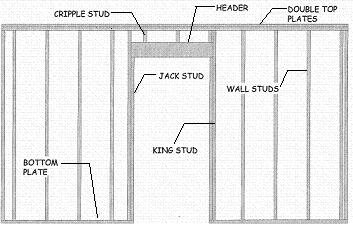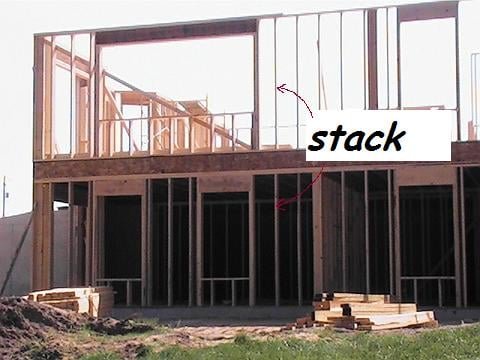How to Frame and Build Walls, Rough Openings, and Headers

Properly Framing and Building Walls
The first thing to know when framing and building walls, is that you will need a bottom plate and two top plates to attach the wall studs to. The double top plate is needed to comply with building code. Code requires a double top plate for load-bearing walls.
Layout the bottom plate and one of the top plates at 16″ on center. That means you will place wall studs every 16 inches. This is a typical spacing for most residential construction. Place your door openings where you want them and layout the correct rough opening size. When building new construction or remodeling, it is best to stack your wall studs directly over the floor joist.
Guess what? Fortunately, most floor joist are also placed on 16″ centers. There are many reasons to do this, let’s start with the obvious:
The strength of the building is increased as every stud bears directly over the floor joist, which in turn is bearing directly on the foundation.
Mechanicals such as heating and plumbing are much easier to run from floor to floor Studs stack over each other in stairwells.
Future renovations or afterthought wiring will be less difficult.
Wall sheathing and drywall panels install with less cutting.
You will need to pick a corner of the house to start all layouts from. Including floor and wall systems. The best spot to start from is where the two longest walls of the house or addition meet, or come together in a corner.
Using this one reference point to complete all layouts from will produce the best result. While this will take a little extra time, and some thought to complete, the benefits will far outweigh the minimal time investment.

Framing Your Door Rough Opening Correctly Will Make Installing Doors Go Smoothly
First, you must determine the size of your door. Measure the door if you already have it. If you don’t, take the actual door size you will be installing and add 2 inches to the width and two and one-half inches to the height.
This will give you the correct rough openings. The reason for the extra space is to allow room for the door frame and for space to adjust the door. Once you have all this information, it’s just a matter of where you want your door.
Decide the location by taking into consideration the traffic flow and the size of items you will furnishing the room with. In bedrooms, it’s best if you can swing the door against a wall. Frame the opening close to the corner if possible, just be sure to leave enough room for the size of trim you will be using. Always use two studs on each side of the opening. The first will be continuous from the top plate to the bottom plate. This is called a king stud.
The next jack stud will be cut to the height of your door plus 2-1/2″ and minus the thickness of the bottom plate 1-1/2″ as it will rest on top of this. So your jack stud should be cut at 81″ for a 6-8″ tall door. Your header size is determined by the load it carries. If you are building a new bearing wall or cutting in a new doorway be sure to check your local building code span charts or consult an engineer to properly size the header.
Once you know the depth of the header, it’s width is cut to fit from king stud to king stud, with the jack studs fitting under it to help disperse the loads. A typical header width with single jack studs is cut 3″ larger than the rough opening.
An example: A 36″ door has a rough opening width of 38″ so your header is cut at 41″. Also, be aware double or triple jack studs may be required based on the opening width and the load the header carries. Be sure to check code requirements prior to framing.
Building Basement Walls
Building a new wall while finishing your basement is a relatively simple task that even a homeowner can tackle with a few pointers. The first step is to verify with your local building department to see if you will need a building permit. Most all codes require a means of egress from the basement when there is habitable space.
If you are building a new home, most codes require means of egress from a basement, regardless of having any habitable space. This can be accomplished with an egress window, that has minimum size and height requirements. The key here is to ask your local jurisdiction first.
Once you have the green light to start construction, start by determining the materials you will need to complete the wall framing. Layout the walls on the floor by measuring and snapping chalk lines where the bottom plate of the walls will rest. Be sure to check the chalk lines for square. It is easier to re-snap a chalk line then to move a wall.
Measure all the areas where the walls will rest on the floor to determine the linear footage of plate your project requires. Don’t forget to add in the top plates of the wall. It will take the same amount of linear footage for the top as the bottom unless the walls are load bearing.
If the bottom plate rest on concrete, it must be treated or a certain species in order to be in contact with the concrete.
If your walls are non-load bearing a single top plate is all that is required. If they are load bearing a double top plate is required.
When framing in 16″ centers, a good rule of thumb when figuring material, is one wall stud per foot of bottom plate. This will usually give you the extra studs needs for corners and door openings. If you want to get closer, here is a site with a wall construction calculator.
Measure and cut the plates accordingly based on the chalk lines snapped. Layout all the wall studs on the top and bottom plates prior to nailing them in place. If you have enough room, build your wall laying down on the floor, this will allow you to face nail all the wall studs in place.
Don’t forget, you will need space to stand the wall up also. If you don’t have room, nail the bottom and top plates in place first, then toenail the wall studs into place.
Read more at: https://ezhangdoor.com/framing-and-building-walls-rough-openings-and-headers/
Congratulations @treyg! You received a personal award!
You can view your badges on your Steem Board and compare to others on the Steem Ranking
Do not miss the last post from @steemitboard:
Vote for @Steemitboard as a witness to get one more award and increased upvotes!